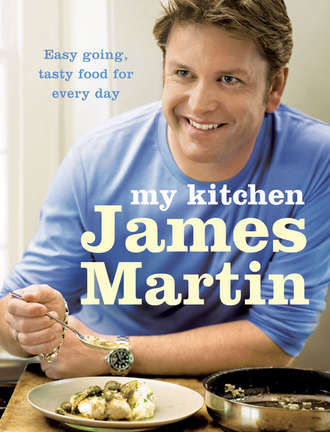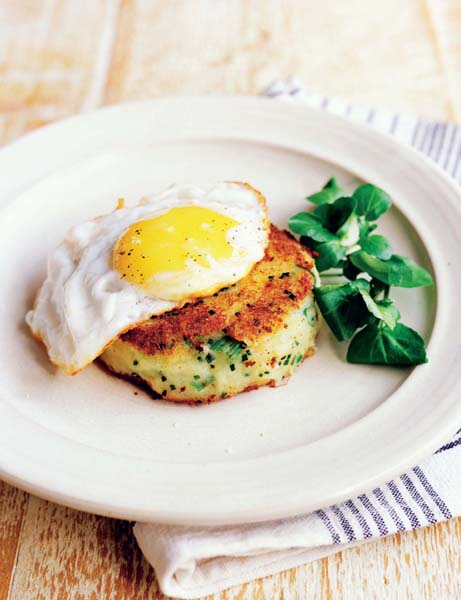
Полная версия
My Kitchen

My Kitchen
James Martin

Table of Contents
Cover Page
Title Page
Introduction
Spring
Spring onion potato cakes with fried duck eggs
Cream of Jerusalem artichoke soup with bacon
Frisée, radish and orange salad
Bibb lettuce salad with radishes
Montgomery cheese balls with rosemary
Seared sea bass with blood orange and spring onion salad
Dill-marinated salmon with lime and rhubarb salad
Grilled halibut with champ and lemon caper butter
Mackerel with caramelised radishes
Cod with clams, curly kale and wild garlic
Trout with green beans and almonds
Wok-fried chicken with ginger, chilli and wild garlic
Sautéed chicken livers and mushrooms on toast
Rack of lamb with vegetable broth
Lamb, mint and Little Gem salad
Côte de boeuf with watercress and black beer mustard
Black beer mustard
Juniper-pickled cucumbers
Sliced Yorkshire ham with poached leeks and spring onions
Scotch eggs with curried salad cream
Pressed ham terrine
Rhubarb and ginger syllabub
Orange cheesecake with roasted rhubarb
Crème caramel with strawberries
Pancakes with pistachio gremolata
Baked Alaska with elderflower meringue
Elderflower fritters with maple syrup
Elderflower and lemon cordial
Summer
Pea soup with Little Gem and marjoram
Sweetcorn soup with crab and basil cream
Deep-fried tomato fritters with red onion salad
Tomato, basil and mozzarella pizzas
Slow-roasted tomatoes with Worcestershire sauce
Soused herrings with red chilli and chive cream
Smoked haddock, globe artichoke and lemon risotto
Scallop and squid salad with fennel and rocket
Spicy crab linguini
Grilled sardines with panzanella
Classic chicken chasseur
Sticky chicken wings
Cold chicken breast with warm red onion and grape salad
Chicken with peach and watercress
Beef and fennel koftas
Lemon and rosemary lamb with tahini aubergines
Marinated loin of lamb with warm figs, coriander and honey
Potted salt beef with gherkins
Spatchcock duck with spicy tamarind glaze
Chargrilled rabbit loin with sweetcorn and chilli relish
Pork spare ribs with coleslaw, star anise and whisky glaze
Pan-fried pork fillet with smoky tomato sauce
Poached cherries with almond glaze
Black cherry brownies
Eggy croissants with fresh raspberries and zabaglione
Oven-roasted apricots with honey madeleines
Lemon verbena cake with strawberries and cream
Teacakes with warm strawberries and clotted cream
Spiced redcurrant jelly
Sweet and sour pickled plums
Autumn
Pumpkin soup with chestnut cream
Hazelnut-coated goat’s cheese with lemon and beetroot salad
Cromer crab toastie
Scrambled duck eggs with crispy bacon and watercress
Marinated mackerel with horseradish and crusty bread
Pan-fried lemon sole with clams, coriander and tomato
Herb-crusted cod with spicy cauliflower cheese
Smoked haddock, leek and mascarpone tart
Salmon and pumpkin risotto
Pot-roasted chicken with pumpkin, sage and star anise
Pan-fried chicken with Waldorf salad
Fillet of beef with beetroot and parsley
Rib-eye steak with stick fries and Chateaubriand sauce
Pan-fried calf’s liver with cider-battered onion rings
Roasted grouse with potato, celeriac and parsnip rosti
Roast duck breast with sherry vinegar plums
Rabbit casserole with white wine and grapes
Venison with parsnip purée and roast beets
Pheasant breasts with onion purée and sautéed greens
Pork escalopes with wild mushrooms, juniper and mash
Swiss-style hazelnut meringues with coffee cream
Welsh cakes with poached pears
Baked custard tart with mulled spiced plums
Damson clafoutis
Pistachio coffee cake
Sloe jam
Winter
Chunky vegetable soup with cheesy herb toasts
Leek and potato soup with smoked salmon and poached eggs
Onion soup with Lincolnshire Poacher
Gnocchi with winter pesto
Scallops with black pudding and apple puree
Spicy mussels with coconut and lime
Deep-fried cod cheeks in beer batter
Pigeon with fried green cabbage and almonds
Roast turkey with Guinness glaze
Breaded turkey with spinach, walnuts and honeyed parsnips
Beef fillet with bacon, cep purée and Jerusalem artichokes
Braised oxtail with beer and red wine
Beef and shallot hotpot
Sliced duck breast with winter stir-fry
Honey-glazed quail with beetroot, apple and hazelnut salad
Breaded pork chops with celeriac purée and herb spätzle
Pork loin with sherry-roasted parsnips and chestnuts
Mango, coriander and apple chutney
Spiced apple chutney
Caramelised pear and almond strudel
Caramelised quince and Cox apple tart
Christmas pudding ice cream with satsumas and caramel sauce
Four-minute figgy pudding with custard
Hot spiced cranberry punch
Stocks, sauces and dressings
French dressing
Vinaigrette
Mint sauce
Creamed horseradish
Mayonnaise
Quick Hollandaise sauce
Tartar sauce
Chicken stock
Fish stock
Vegetable stock
Supplier list
Acknowledgements
Index
Copyright
About the Publisher
Introduction
“It’s all in a season.” That’s what my granddad used to say to me. A keen gardener, he would to take me to his allotment and greenhouse whenever I went to visit. That was my first real insight into fresh food and where it comes from – before that it had just been microwaved jacket potatoes or steak with onion rings from a Berni Inn. So, I’m sure it was there – right there – aged five, that the seeds were planted in my mind, and I knew I was going to be a cook.
Many people in the UK grow up in urban areas with little or no awareness of where their food comes from and when it is actually in season. In my opinion, this is mainly down to the supermarkets offering the same food week-in, week-out. But the seasons are the planet’s natural cycle and they exist for a reason, so it makes no sense to try and beat them. Think of each changing season as ‘out with the old and in with the new’, welcome the next lot of produce and don’t go searching for out-of-season food. There are so many good reasons to eat what we produce locally, the obvious ones being to support the British farmers, to reduce CO2 emissions from transport, and above all else to get the best possible taste. You only have to try Jersey Royals or British strawberries to understand what I mean.
In a country obsessed with cheaper and cheaper food, we should take a step back and re-assess. If we want great food on our plates we have to be willing to pay for it. I’m not saying it has to be expensive – we’re still talking pence, not pounds and, in fact, food is at its cheapest when in season – even luxury foods like asparagus. Things are already changing for the better, with people learning more about food from books and TV programmes and paying closer attention to what they are eating. But more can still be done. We just need to get out of the habit of expecting what we want whenever we want it. It has always been my mission to champion the food that’s on our doorstep, and this is exactly the food I cook at home, in my own kitchen.
Those who have their own garden or allotment will always have access to the utmost in fresh produce. They will also know that it’s a great teaching tool for young and old alike, and that growing your own food can be a source of much satisfaction. Most importantly, if we eat seasonal food it will be at its cheapest because of its abundance, and the flavour will be at its best. This book is all about celebrating this island of ours, and the food that grows on it, and the best way I can get you excited about cooking this way in your own home is to give you the recipes I cook in my own throughout the year.
Enjoy,
James
Spring
Radishes • Asparagus • Spring onions • Leeks Jerusalem artichokes • Spinach • Elderflowers Rhubarb • Parsley • Lamb • Sea bass • Salmon
Spring brings a garden to life with the promise of delicious crops to come. In Britain we can enjoy seasonal produce such as wild garlic, Jerusalem artichokes and watercress. Radishes and spring onions push up through the soil and elderflowers fill the hedgerows. Sea bass and salmon are a real treat for seafood lovers, while for meat eaters the end of the season brings with it succulent spring lamb. And I wouldn’t be a true Yorkshireman if I didn’t mention the best bit of all – rhubarb! Harvest from the garden or enjoy the tender pink forced variety, still available at this time of year.
Spring onion potato cakes with fried duck eggs
Serves 4
Vegetarian
4 large floury potatoes, peeled and quartered
½ bunch of spring onions, finely chopped
2 tbsp chopped chives
110g (4oz) flour, for dusting
150ml (5fl oz) olive oil
110g (4oz) butter
4 duck eggs
200g (7oz) watercress
50ml (2fl oz) extra-virgin olive oil
20ml (¾fl oz) white wine vinegar
Salt and black pepper
Potato cakes are excellent as a starter or as a filling snack. They can be prepared in advance and kept in the fridge until needed. Duck eggs are a Saturday Kitchen favourite. Cook them just like hens’ eggs; however, they’re too rich to use in baking.
Place the potatoes in a large saucepan, cover with water and add a good pinch of salt. Bring to the boil and cook for 20–25 minutes, then drain and return to the pan. With the pan on a heatproof surface, mash the potatoes well, then transfer to a large bowl and season with salt and pepper. Mix in the spring onions and chives and divide the mixture into eight balls.
Lightly dust a work surface with flour, place a potato ball on it and shape into a round, flat cake about 1cm (½in) thick and 5cm (2in) wide. Repeat with the rest of the potato and place the finished cakes in the fridge for about an hour to firm up.
Add the olive oil to a non-stick frying pan, dust the potato cakes with flour and fry over a medium heat for 3–4 minutes on each side. Depending on the size of the pan, you may have to cook them in batches.
While the potato cakes are cooking, melt the butter in another non-stick frying pan, set over a medium heat, and once it is hot and bubbling, crack the duck eggs into the pan and cook them until the edges are crispy but the centres remain soft.
Dress the watercress with the extra-virgin olive oil and the vinegar and season with salt and pepper, to your taste. Place 1–2 potato cakes on each plate, top with a fried egg, drizzle with the leftover butter from the egg pan and serve with some watercress on the side.

Cream of Jerusalem artichoke soup with bacon
Serves 4
300g (11oz) Jerusalem artichokes
1 large shallot
1 small potato
4 tbsp extra-virgin olive oil
1 clove of garlic, peeled and crushed
500ml (18fl oz) Vegetable Stock (see page 218)
3 rashers of smoked streaky bacon
110ml (4fl oz) double cream
Salt and black pepper
Crusty bread, to serve
Jerusalem artichokes are the roots of a plant related to the sunflower. They come into season very early in spring, sometimes even earlier, at the tail end of winter. Despite having the same name, the globe artichoke comes from a completely different plant and isn’t in season until the summer. Jerusalem artichokes make excellent soup; I also love them in purées, salads or simply sautéed.
Peel the artichokes, shallot and potato and chop into 1cm (½in) cubes. Set a large, heavy-based saucepan over a medium heat and add 2 tablespoons of olive oil. Tip in the vegetables and fry gently for 2–3 minutes, without browning.
Add the garlic and pour in the vegetable stock. Bring to the boil and cook for 8–10 minutes or until the artichokes and potato are cooked through and soft.
Meanwhile, heat the grill to high and grill the bacon on both sides until crispy, then set aside. Once cool, cut into pieces.
Add the cream to the soup, bring back up to the boil and cook for another 2–3 minutes. Remove the pan from the heat, then pour the soup into a blender and puree until smooth. Alternatively, puree the soup using a held-held blender.
Return the soup to the pan, reheat gently and add salt and pepper, to taste. Pour the soup into bowls and sprinkle with small pieces of the bacon. Drizzle with the remaining olive oil and serve with fresh crusty bread.
Frisée, radish and orange salad
Serves 4
Vegetarian
3 oranges
½ head frisée lettuce
4 radishes, sliced
½ bunch of chives, in 2.5cm (1in) lengths
1 tbsp white wine vinegar
5 tbsp extra-virgin olive oil
Salt and black pepper
This refreshing salad makes a great accompaniment to fish, especially smoked salmon. The outer leaves of frisee lettuce can be bitter, so use the inner leaves only.
Zest two oranges, then peel and break the segments into a large bowl. Add the lettuce leaves, radish slices and chives.
To make the dressing, put the zest in another bowl with the juice of the third orange and the vinegar. Whisk in the olive oil and season with salt and pepper.
Pour the dressing over the salad, toss the leaves to coat evenly and serve immediately.
Bibb lettuce salad with radishes
Serves 4
Vegetarian
4 heads of Bibb lettuce
6 tbsp chopped mixed
fresh herbs
2 shallots 8 radishes
1 tbsp Dijon mustard
2 tbsp red wine vinegar
5 tbsp rapeseed oil
Salt and black pepper
A simple salad, ideal with grilled chicken or fish. If you can’t get Bibb lettuce, use Little Gem instead; and feel free to replace the rapeseed oil with a good-quality extra-virgin olive oil.
Cut away the base section from each lettuce and place the leaves in a large bowl. Add all the herbs to the bowl and mix well together. Peel and thinly slice the shallots, slice the radishes and layer both with the salad leaves onto plates.
In a separate bowl, mix together the mustard and vinegar and slowly add the rapeseed or olive oil. Season well with salt and pepper, drizzle the dressing over the salad leaves and serve.
Montgomery cheese balls with rosemary
Serves 4
Vegetarian
450ml (16fl oz) milk
125g (4½oz) Montgomery’s Cheddar or any good-quality, mature Cheddar cheese
20g (¾oz) butter, plus extra for greasing
150g (5oz) plain flour
2 whole eggs, beaten
6 eggs, separated into whites and yolks
2 tbsp finely chopped rosemary leaves
300g (11oz) dried breadcrumbs, such as Japanese panko
1.2 litres (2 pints) vegetable oil, for deep-frying
Salt and black pepper
These are excellent as canapés, as a starter or, in larger quantities, as a vegetarian main course. Serve simply with salad, such as the Bibb Lettuce Salad with Radishes (see page 13).
Gently warm the milk in a small saucepan over a low heat – do not let it boil. Grate the cheese into a bowl and set aside.
Place the butter, flour, beaten eggs and the six yolks in a large saucepan, add the grated cheese and set over a low heat. Gradually add the warm milk, stirring continuously with a whisk to prevent lumps. Once all of the milk has been added, keep stirring until the mixture begins to thicken.
When the mixture starts to come away from the sides of the pan, season with salt and pepper and pour out on to a greased baking tray to cool. Once cool, mould the mixture into balls each about the size of a golf ball and place in the fridge for 30 minutes to firm up.
Beat the egg whites in a bowl and mix the rosemary and breadcrumbs in another bowl. Dip the cheese balls first into the egg white, then the rosemary breadcrumbs and either cook straight away or return to the fridge and cook later.
If using a deep-fat fryer, heat the vegetable oil to 190°C (375°F). Alternatively, fill a deep, heavy-based frying pan to a depth of 2cm (¾in) with oil and use a sugar thermometer to check that it has reached the correct temperature.
Remove the balls from the fridge and lower into the fryer or pan. Cook for 4–5 minutes until golden brown, then carefully lift out with a slotted spoon, drain on kitchen paper and serve.
Seared sea bass with blood orange and spring onion salad
Serves 4
4 blood oranges
1 bunch of spring onions, cut into 2.5cm (1in) lengths
200g (7oz) mixed salad leaves
1 tbsp olive oil
4 × 125g (4½oz) sea bass fillets, all bones removed
1 bunch of basil, leaves only
Salt and black pepper
For the dressing
25ml (1fl oz) white wine vinegar
Pinch of caster sugar
110ml (4fl oz) extra-virgin olive oil
Farmed sea bass has become widely available in recent years, but if you can get hold of line-caught bass it’s definitely worth the extra cost. Blood oranges are a beautiful deep red colour and have a much more distinctive flavour than regular oranges (although you could use these as an alternative). They go well in savoury dishes and salads.
Peel three of the oranges and break the segments into a large bowl along with the spring onions. Season with salt and pepper, then add the salad leaves and toss together. Set aside.
To make the dressing, squeeze the juice from the remaining orange into another bowl and mix with the vinegar and sugar. Whisk in the extra-virgin olive oil until fully incorporated. Drizzle a little of the dressing over the prepared salad and toss together to coat.
Pour the olive oil into a non-stick frying pan set over a high heat. Place the sea bass fillets in the pan, skin side down, and sear for 3–4 minutes or until the sides of the fish start to brown. Turn over, cook for 1 more minute, add half the basil and remove from the heat, keeping the fish in the pan to allow them to carry on cooking in the residual heat. Set aside.
Divide the salad between plates, then lift the sea bass fillets from the pan and place on top of the salad. Scatter with the remaining basil, drizzle over the rest of the dressing and serve.
Dill-marinated salmon with lime and rhubarb salad
Serves 4
2 sticks of rhubarb, any leaves removed
25g (1oz) pickled ginger, finely chopped, and juice
Zest and juice of 1 lime
50ml (2fl oz) extra-virgin olive oil
15g (½oz) chives, chopped
2 × 250g packets of dill-marinated salmon or smoked salmon
Salt and black pepper
1 lemon, cut into wedges, to serve
Crusty bread, to serve
My chef, Chris, came up with this idea while experimenting in the kitchen. I liked the combination of these ingredients so much that I put it on the menu at my bistro. If you can’t find dill-marinated salmon, just use regular smoked salmon instead.






